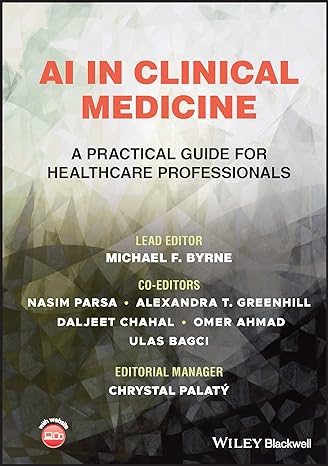|
|
|
| |
 |
|
|

|
 推薦指數:
推薦指數:





|
|
- 內容介紹
|
AI in Clinical Medicine: A Practical Guide for Healthcare Professionals 1st Edition
by Michael F. Byrne (Editor), Nasim Parsa (Editor), Alexandra T. Greenhill (Editor), Daljeet Chahal (Editor)
Publisher : Wiley-Blackwell; 1st edition
Language : English
Hardcover : 592 pages
ISBN-10 : 1119790646
ISBN-13 : 978-1119790648
Item Weight : 3.1 pounds
2023
AI IN CLINICAL MEDICINE
An essential overview of the application of artificial intelligence in clinical medicine
AI in Clinical Medicine: A Practical Guide for Healthcare Professionalsis the definitive reference book for the emerging and exciting use of AI throughout clinical medicine. AI in Clinical Medicine: A Practical Guide for Healthcare Professionals is divided into four sections. Section 1 provides readers with the basic vocabulary that they require, a framework for AI, and highlights the importance of robust AI training for physicians. Section 2 reviews foundational ideas and concepts, including the history of AI. Section 3 explores how AI is applied to specific disciplines. Section 4 describes emerging trends, and applications of AI in medicine in the future.
Readers will find that this book:
Describes where AI is currently being used to change practice, and provides successful cases of AI approaches in specific medical domains.
Dives into the actual implementation of AI in the healthcare setting, and addresses reimbursement, workforce, and many other practical issues.
Addresses some of the unique challenges associated with AI in clinical medicine including ethical issues, as well as regulatory and privacy concerns.
Includes bulleted lists of learning objectives, key insights, clinical vignettes, brief examples of where AI is successfully deployed, and examples of potential problematic uses of AI and possible risks.
From radiology, to pathology, dermatology, endoscopy, robotics, virtual reality, and more, AI in Clinical Medicine: A Practical Guide for Healthcare Professionals explores all recent state-of-the-art developments in the field. It is an essential resource for a general medical audience across all disciplines, from students to clinicians, academics to policy makers.
|
|
|

